I love herbal medicine but I’ve never grown herbs—how do I begin an herb garden?
Have you or someone you know been asking this question lately? Then read on for inspirational and empowering steps for growing medicinal herbs at home—we give even the brownest thumb enough fertilizer to succeed in medicinal herb gardening! We’ll help feed the roots for a DIY herb garden that will leave both you and your plants grounded. If you want more tips, see Juliet’s article on growing the herb garden of your dreams.
The Time Is Now to Start Your First Herb Garden
I’ve grown vegetables, flowers, fruit trees, berries, and ornamentals, but my favorite thing across the board is growing medicinal herbs. They are so satisfying—once you have them established, they will generously give you medicine year after year after year. When you are able to fill your own apothecary, you’ll feel a sense of sovereignty that can’t be bought. Take this opportunity to get your own medicine growing now as the harvest doesn’t happen overnight! You will also be able to better apply the in-depth knowledge found in Juliet’s forthcoming book, The Healing Garden: Cultivating & Handcrafting Herbal Remedies.
In this present time of COVID-19, and the food and herb shortages we have already experienced, growing your own medicine becomes even more essential.
Key Takeaways:
- Starting a basic medicinal herb garden is easier than you think.
- Growing your own medicinal herbs can provide a sense of sovereignty and self-sufficiency.
- With the right knowledge and resources, you can cultivate and handcraft your own herbal remedies.
- Growing your own medicine becomes even more essential in times of food and herb shortages.
Mary Plantwalker gardening in her lavender bed
Introduction to Medicinal Herb Gardening
If you’ve ever been curious about growing your own medicinal herbs but didn’t know where to start, you’re not alone. Many people are drawn to the idea of using plants for their health and well-being, but navigating the world of medicinal herb gardening can seem overwhelming at first. However, with some basic knowledge and a little bit of planning, you can start your own herb garden and reap the benefits of growing your own medicine.
When I first started exploring medicinal herb gardening, I felt like I had entered a whole new world. There were so many questions running through my mind: Are herbal remedies safe? Which plants should I grow? How do I use them? Can I grow them at home?
But I took small steps and started learning. I read books and online resources, testing out different herbal remedies and taking notes along the way. And slowly but surely, I began to find my footing in the world of medicinal herb gardening.
If you’re ready to take the plunge and start your own herb garden, here are some simple steps to get you started:
- Make a List of Common Ailments in Your Family: To design your medicinal garden for your specific needs, start by identifying the common health issues in your family. This will help you determine which herbs to prioritize in your garden. For example, if you frequently experience headaches, you might want to grow herbs like feverfew or lavender.
- Read Medicinal Herb Books and Resources: Educating yourself about medicinal herbs is essential to becoming a successful herb gardener. Start by reading reputable resources that provide information on different herbs, their uses, and recipes for remedies. I found books like “Medicinal Herbs: A Beginner’s Guide” by Rosemary Gladstar and “Healing Herbal Infusions” by Colleen Codekas to be helpful starting points.
- Take Notes of Plants Common in Medicinal Herb Gardening: As you read through resources, take notes on the herbs that keep appearing in the recipes you’re interested in trying. Identify the herbs that align with your family’s needs and those that can be used in multiple remedies. This will help you create a list of herbs to grow in your garden.
- Test Interesting Herbal Remedies: Before committing to growing all the herbs on your list, it’s a good idea to test out some remedies first. If it’s not currently the growing season, you can buy small amounts of the herbs and try out the recipes in the off-season. This will help you determine which herbs are most important to you and deserve a place in your garden.
- Make a List of Herbs You Want to Grow: After testing different remedies, make a final list of the herbs you want to grow in your garden. Consider the growing needs of each herb and group together those that require similar conditions. Research which herbs are perennial and which ones need to be planted each season.
- Decide on the Garden Design: Determine where you will plant your herbs based on your available space and preferences. You can create a dedicated medicinal herb garden, incorporate herbs into your existing vegetable garden, or mix them throughout your landscape. Consider companion planting and the aesthetic appeal of different arrangements.
- Plan Your Medicinal Herb Seed Starting and/or Transplant Dates: Decide whether you will start your herbs from seeds or purchase transplants. Seeds are more economical but have a slower germination rate, while transplants allow for quicker harvest but can be harder to find. Make a plan for when to start your seeds or when to purchase transplants based on your local climate and growing season.
By following these steps, you’ll be well on your way to starting your own medicinal herb garden. Remember to start small, stay connected to nature, and enjoy the process of growing your own medicine. Soon enough, you’ll be harvesting herbs and creating your own herbal remedies.

Next, we’ll explore the benefits of growing medicinal herbs. Stay tuned!
The Benefits of Growing Medicinal Herbs
Growing medicinal herbs at home offers a multitude of benefits for both your health and overall well-being. Here are some of the key advantages of cultivating your own medicinal herb garden:
- Access to Natural Remedies: Having a medicinal herb garden gives you easy access to a wide range of natural remedies that can help alleviate common ailments. From soothing teas to healing salves, you’ll have the tools to address various health issues right at your fingertips.
- Cost-Effective Solution: Purchasing herbal remedies from the store can be expensive, especially if you use them frequently. By growing your own medicinal herbs, you can save money in the long run, as you’ll only need to invest in seeds or seedlings and basic gardening supplies.
- Quality Control: When you grow your own medicinal herbs, you have complete control over the quality and purity of the plants. You can ensure that no harmful chemicals or pesticides are used, resulting in a higher quality product for your herbal remedies.
- Environmental Sustainability: By growing your own medicinal herbs, you reduce your reliance on commercially grown herbs, which often require intensive farming practices and long-distance transportation. Growing your herbs locally promotes environmental sustainability and reduces carbon emissions.
Aside from these benefits, cultivating a medicinal herb garden can also be a rewarding and therapeutic experience. It connects you with nature, allows you to participate in the ancient practice of herbal medicine, and empowers you to take control of your health and well-being.
Having a medicinal herb garden gives you easy access to a wide range of natural remedies that can help alleviate common ailments.
Growing Medicinal Herbs Responsibly
It’s important to note that not all herbs are suitable for medicinal use, and some may have potential risks or interactions with certain medications. It’s crucial to do thorough research and consult with a qualified herbalist or healthcare professional before using any herbal remedies.
Additionally, it’s essential to grow medicinal herbs responsibly and ethically. Avoid harvesting herbs from the wild, as this can deplete natural populations and disrupt ecosystems. Instead, opt for sourcing your seeds or seedlings from reputable organic suppliers or consider saving seeds from your own garden.
When harvesting your medicinal herbs, practice sustainable harvesting techniques by only taking what you need and allowing the plants to regenerate. Consider incorporating companion plants and beneficial insects into your garden to promote a healthy ecosystem and natural pest control.
By growing medicinal herbs responsibly, you not only ensure the sustainability of these valuable plants but also contribute to the preservation of traditional herbal knowledge and practices.

In conclusion, growing your own medicinal herb garden offers numerous benefits, from easy access to natural remedies to cost savings and environmental sustainability. Take the first step today and start cultivating your own healing garden—it’s a journey that will nourish both your body and soul.
Reflecting on Your Intention for Starting an Herb Garden
Before diving into the exciting world of medicinal herb gardening, it’s important to take some time to reflect on your intention for starting an herb garden. Understanding the reasons behind your desire to grow medicinal herbs will help guide your actions and ensure that your garden aligns with your goals.
1) Intention: What is my intention for growing an herb garden? Why am I doing this?
Getting clear about your intention is crucial for a successful and fulfilling herb garden. It can bring focus and purpose to your gardening journey and help you make decisions that align with your goals. Consider the following questions:
- Is this herb garden for me or my family?
- Am I aiming to create a small business apothecary?
- Am I growing herbs to sell to a wholesaler?
- Or perhaps there’s another intention altogether?
Whatever your reasons for starting an herb garden, knowing and understanding them will guide your choices and ensure that your garden meets your unique needs.
2) Space: What kind of space is available to me?
Assessing the available space for your medicinal herb garden is essential for determining which herbs you can grow and whether your intention is currently feasible. Consider the following questions:
- Are you in a rental situation that may make it wise to use containers?
- Do you have already-established beds or will you need to create them?
- Will you have space to expand your garden in the future if you choose to?
Understanding the space you have for growing medicinal herbs will help you make informed decisions about your garden layout and the types of herbs you can cultivate.
3) Energy: Evaluating your energy level, time commitment, and available resources
Knowing your energy level and considering the time commitment and resources you have will give you a realistic compass for planning your herb garden. Reflect on the following questions:
- Will you be tending to the garden alone, or do you have help?
- What kind of time commitment are you willing to make to this herb garden?
- Do you have or need a lot of money to begin, or can you get resourceful with the materials around you?
Evaluating your energy and resources will help you determine the scale and scope of your herb garden and ensure that it remains a source of joy and inspiration.
Choosing the Right Medicinal Herb Plants for Your Garden
Now that you’ve reflected on your intention, assessed your available space, and evaluated your energy and resources, it’s time to choose the right medicinal herb plants for your garden. Selecting the right herbs will depend on your personal needs, preferences, and goals. Consider the following:
- Are there specific health issues you’d like to address?
- Do you want to create an immune-boosting garden or an aromatic tea garden?
Identifying your specific needs and goals will help guide your herb selection process. Chestnut’s Top Ten Medicinal Herbs for the Garden can provide you with valuable insights and recommendations for tried and true medicinal herbs.
Remember, it’s important to choose herbs that are safe and appropriate for your intended use. Research each herb’s properties and potential interactions and consult with a healthcare professional if needed.
Now that you’ve laid the groundwork by reflecting on your intention and choosing the right medicinal herb plants, you’re ready to embark on the next step of your herb gardening journey: starting your medicinal herbs from seeds or seedlings.
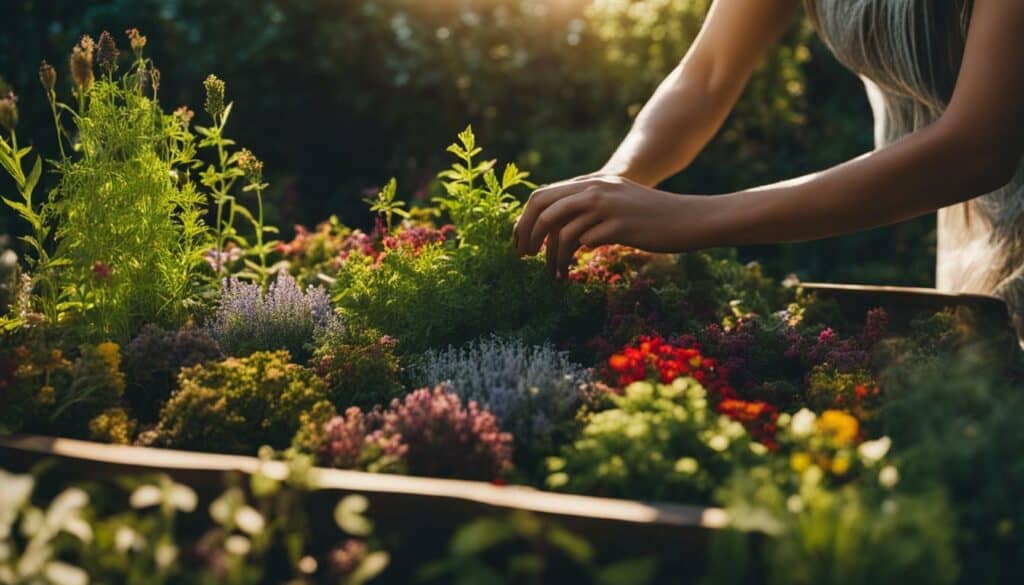
Stay tuned for the upcoming section on starting your medicinal herbs from seeds or seedlings to continue your herbal gardening adventure!
Determining the Space for Your Medicinal Herb Garden
When it comes to starting a medicinal herb garden, one of the first things to consider is the space available to you. Whether you have a small balcony or a spacious backyard, there are options for every type of gardener. Let’s explore some factors to consider when determining the space for your medicinal herb garden.
1. Assessing Your Available Space
Take a look at the area where you plan to grow your medicinal herbs. Consider whether you have a dedicated garden bed, containers, or even a portion of your existing landscape that can be repurposed for your herb garden.
If you’re limited on space, don’t worry! Medicinal herbs can thrive in containers, making them ideal for small gardens or urban environments. You can use window boxes, hanging baskets, or even repurpose old containers to create a vertical herb garden.
2. Sunlight Requirements
Most medicinal herbs require at least six hours of direct sunlight per day. Take note of how much sunlight your chosen space receives throughout the day. Observe which areas are shaded, partially shaded, or receive full sunlight.
If your chosen space doesn’t receive enough sunlight, consider using reflective surfaces, such as mirrors or white walls, to redirect sunlight to your herbs. You can also choose herbs that tolerate partial shade, such as lemon balm or mint.
3. Soil Quality and Drainage
It’s important to assess the quality of your soil and its drainage capabilities. Medicinal herbs generally prefer well-draining soil to prevent root rot and other moisture-related issues.
If your soil is heavy and clay-like, consider amending it with organic matter such as compost or well-aged manure. This will improve drainage and provide essential nutrients for your herbs.
4. Companion Planting Opportunities
Another aspect to consider when determining your herb garden’s space is companion planting. Some herbs, like basil, dill, or chamomile, can benefit the growth and health of other herbs or vegetables.
Consider which herbs can be planted in close proximity to each other to create a symbiotic relationship. For example, planting garlic near roses can help deter pests, while planting dill near cucumbers can improve pollination.
5. Accessibility and Maintenance
Think about the accessibility of your chosen space. Will you be able to easily water, prune, and harvest your medicinal herbs? If your space is far from your home or if it requires climbing stairs or navigating obstacles, it may become difficult to maintain your garden regularly.
Consider the time and effort you can dedicate to your herb garden maintenance. If you have limited time, opt for low-maintenance herbs that require less care and attention.
6. Planning for Expansion
Lastly, think about the potential for expansion in the future. If you have the space, consider leaving room for additional herbs or expanding your garden as your knowledge and interest in medicinal herbs grow.
Remember, starting small and gradually expanding is a great way to ensure success and avoid becoming overwhelmed.
By carefully assessing your available space and considering these factors, you can create a suitable environment for your medicinal herb garden. Whether it’s a small balcony garden or a sprawling backyard oasis, growing medicinal herbs is a rewarding and empowering experience.
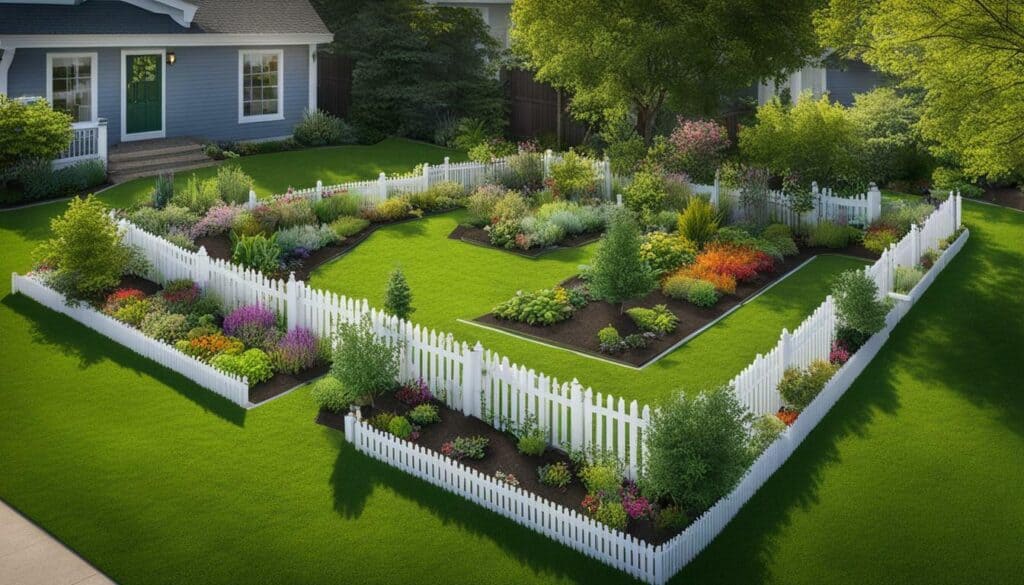
Evaluating Your Energy and Resources for Herb Gardening
Before diving headfirst into starting your medicinal herb garden, it’s important to take a step back and evaluate your energy and resources. Understanding your limitations and capabilities will help you plan your garden effectively and ensure a successful gardening journey.
1) Evaluating Your Intention
Take some time to reflect on your intention for growing an herb garden. Ask yourself why you are doing this and what you hope to achieve. Your intention will serve as a guiding force throughout your gardening journey.
Are you growing herbs for personal use or for your family’s health needs? Are you considering starting a small business selling medicinal herbs? Understanding your intention will help you make informed decisions when choosing which herbs to grow and how to care for them.
2) Determining the Space Available
Next, consider the space you have available for your herb garden. If you’re in a rental situation with limited outdoor space, you may need to use containers for your herbs. Evaluate whether you have established beds or if you need to create new ones.
Think about whether you have room to expand your garden in the future if needed. If space is tight, you can explore growing medicinal herbs in containers or using vertical gardening techniques to maximize your available space.
3) Assessing Your Energy Level and Resources
Being honest about your energy level and available resources is crucial for a successful herb garden. Evaluate whether you will be gardening alone or if you have help from others. Consider the time commitment you’re willing to make for tending to your herbs.
Think about the financial aspect as well. Do you have a budget for gardening supplies, or can you get resourceful with materials you already have? Being aware of your energy level, time, and financial resources will help you plan your garden layout and choose herbs that align with your capabilities.
If you’re unsure where to start, consider picking a handful of herbs that align with your specific needs or health goals. For example, if you’re looking to address particular health issues or create an immune-boosting garden, Chestnut’s Top Ten Medicinal Herbs for the Garden can provide guidance.
4) Planning Your Herb Garden Layout
Once you have evaluated your intention, space, energy, and resources, it’s time to plan the layout of your medicinal herb garden. You can combine indoor and outdoor herb garden containers, planters, window boxes, or dedicate a separate area in your yard.
Get creative with your design and consider visuals that inspire you. Drawing a map of your desired garden layout or browsing through gardening books and online resources can help you gather ideas. You can even volunteer with a local herbal medicine gardener to gain firsthand experience and inspiration.
5) Preparing the Soil
The quality of your soil is essential for growing healthy medicinal herbs. Observe the soil in your chosen garden area and determine if it needs any amendments. Good soil nourishes your plants and, in turn, provides you with high-quality medicine.
If your soil needs improvement, consider adding organic compost or aged manure to enhance its fertility. Organic soil is crucial for the success of your herbs, as it ensures they grow in pesticide and herbicide-free conditions.
6) Choosing the Right Medicinal Herb Plants
Now comes the exciting part—selecting the medicinal herb plants for your garden. Refer back to the list of herbs you want to grow, based on your research and intention. Consider whether you want to start plants from seeds or purchase seedlings, keeping in mind the time and cost factors.
Some herbs are easier to grow from seed, while others may require more expertise or longer germination periods. Research the specific requirements of each herb on your list and group them based on their growing conditions. This will help you plan your garden layout effectively.
7) Starting Your Herbs from Seeds or Seedlings
If you decide to start your herbs from seeds, prepare for a slower germination process. Some herbs may take 2–3 weeks or longer to emerge from the ground. However, starting from seeds is more cost-effective and allows you to have a wider variety of herbs in your garden.
On the other hand, if you choose seedlings, you can expect faster growth and earlier harvest. However, finding organic medicinal seedlings may be challenging, so be prepared to search for reputable sources or consider starting your own seedlings.
Regardless of whether you choose seeds or seedlings, make sure to follow proper planting and care instructions for each herb to ensure their healthy growth.
By evaluating your energy and resources, you’ll be able to plan and create a medicinal herb garden that aligns with your capabilities and goals. Remember, starting slow and small is always better than taking on too much and feeling overwhelmed. Enjoy the journey and find joy in tending to your own medicine garden!
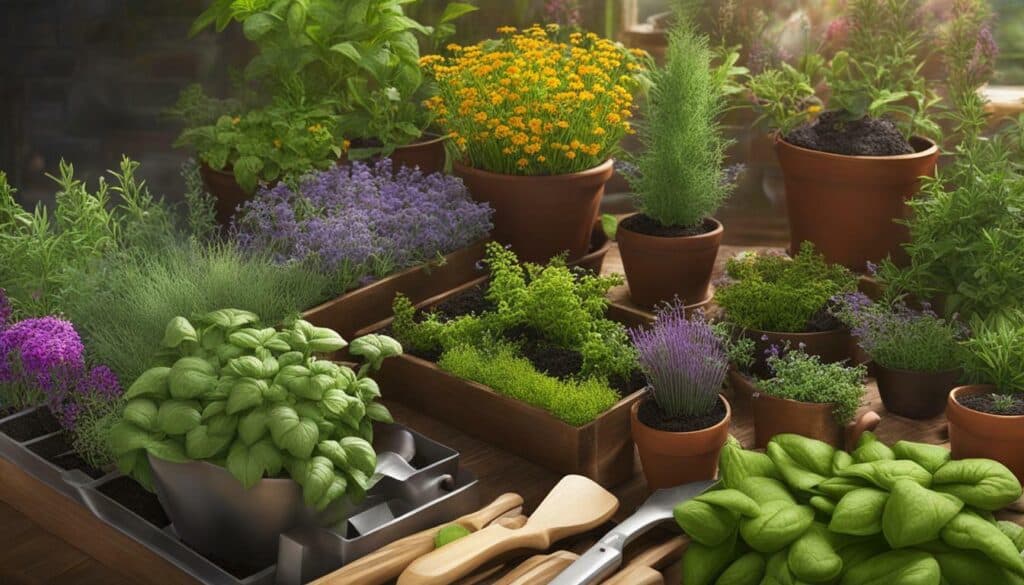
Planning Your Medicinal Herb Garden Layout
Your medicinal herb garden design can be a combination of indoor and outdoor herb garden containers and planters, window boxes, and garden space, or just one of these. I love having multiple herb garden designs as they bring texture, beauty, and different settings for medicine in various places throughout my homestead. I have a spiral garden, raised beds, herb containers, medicinal houseplants, rows and squares and triangle plots, and more. Get creative!
Perhaps you are a visual person and drawing a map of what you want your medicinal herb garden to look like will help with the layout process. Or if you are a list maker, write down the things you will need to do so that you are able to best prioritize them. Flipping through pages of inspirational gardening books or surfing the internet for medicinal herb garden images may be a fun way to mine ideas. Another tip is to find an herbal medicine gardener you admire in your area and volunteer with them so you can see firsthand what resonates for you and learn straight from the source.

Creating a well-designed layout for your medicinal herb garden is not only visually appealing but also functional. Consider the following factors when planning your layout:
Space
Assess the available space you have for your medicinal herb garden. Determine whether you have enough room for raised beds, containers, or a designated garden area. If you have limited space, consider utilizing vertical gardening techniques or growing herbs in hanging baskets to maximize your growing area.
Companion Planting
Take advantage of companion planting principles when deciding which herbs to grow together. Some herbs have beneficial effects on each other, such as repelling pests or improving growth. For example, planting basil near tomatoes can enhance the flavor and health of both plants. Research companion planting combinations that work well with medicinal herbs to create a symbiotic garden ecosystem.
Accessibility
Consider how accessible your herbs will be in the garden. Plant commonly used herbs closer to your home or patio for easy access when you need them. This will make it convenient for harvesting and tending to your herbs regularly.
Sunlight and Shade
Observe the sunlight and shade patterns in your garden area. Most medicinal herbs prefer full sun conditions, while others can tolerate partial shade. Arrange your garden layout accordingly, placing sun-loving herbs in areas that receive the most sunlight and shade-tolerant herbs in partially shaded zones.
Grouping and Spacing
Group herbs with similar growing requirements together to simplify care and maintenance. This will ensure that each herb receives the appropriate amount of water, sunlight, and nutrients. Leave enough space between plants to allow for optimal growth and airflow. Proper spacing will also prevent overcrowding and competition for resources.
Organic Practices
If you are practicing organic gardening, make sure to plan your layout in a way that enables crop rotation and soil preservation. Avoid planting the same herbs in the same location year after year to prevent the buildup of pests and diseases. Incorporate cover crops and green manure into your rotation to improve soil fertility and protect against erosion.
Remember, your medicinal herb garden layout is a personal expression of your gardening style and preferences. Be creative and design a space that reflects your unique vision. By planning thoughtfully and incorporating these considerations, you can create a functional and beautiful medicinal herb garden that will provide you with an abundant supply of healing herbs for years to come.
The Importance of Preparing the Soil for Your Medicinal Herbs
One of the most critical steps in growing a successful medicinal herb garden is preparing the soil. The quality of the soil directly affects the health and vitality of your plants, as well as the potency of the medicinal properties they contain. Here are some key considerations when it comes to soil preparation:
- Amending the Soil: While herbs are generally more forgiving than other plants when it comes to soil type, it’s still important to provide them with nutrient-rich soil. Consider adding organic matter such as compost or aged manure to improve the soil’s fertility and moisture-holding capacity.
- Testing the pH: Different herbs thrive in different pH ranges, so it’s essential to test the pH of your soil to ensure it falls within the ideal range for your chosen herbs. Most herbs prefer a slightly acidic to neutral pH level of 6.0 to 7.0. You can use a pH testing kit available at garden centers or send a soil sample to a professional laboratory for analysis.
- Ensuring Good Drainage: Herbs generally prefer well-drained soil to prevent root rot and other water-related issues. If your soil tends to be heavy and clayey, consider improving drainage by incorporating sand or perlite into the soil.
- Removing Weeds and Debris: Before planting your medicinal herbs, it’s important to remove any weeds, rocks, or debris that may hinder their growth. Clear the area thoroughly, ensuring that your herbs have ample room to spread their roots and access necessary nutrients.
By taking the time to properly prepare the soil for your medicinal herbs, you are setting the stage for healthy and thriving plants that will provide you with abundant medicinal benefits. Remember to always opt for organic methods and materials to ensure the purity and potency of your herbal remedies. With a well-prepared and nourished soil, your medicinal herb garden will flourish, and you’ll be able to enjoy the healing power of nature right in your own backyard.
“By taking the time to properly prepare the soil for your medicinal herbs, you are setting the stage for healthy and thriving plants that will provide you with abundant medicinal benefits.”
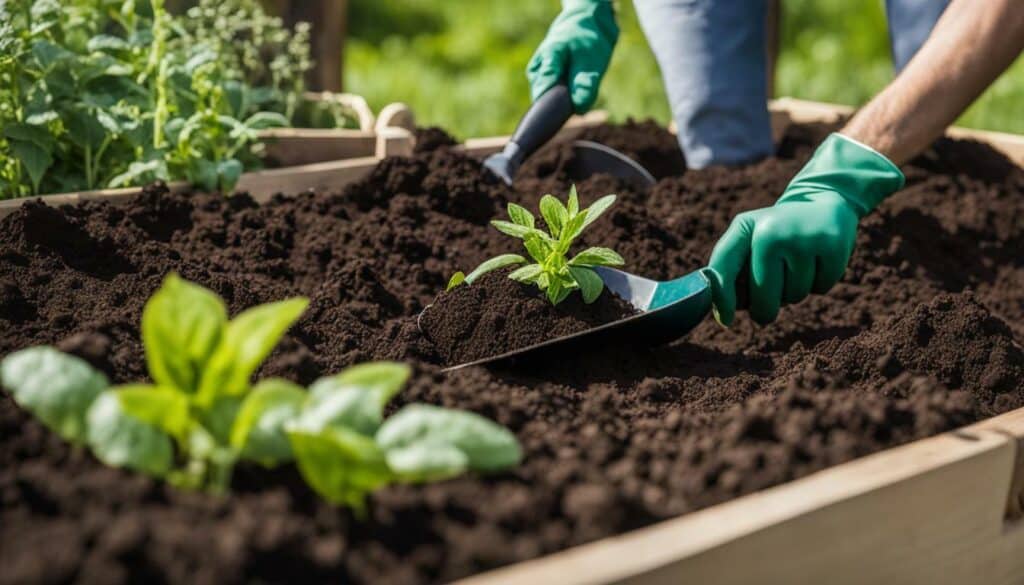
Table: Recommended Soil pH Levels for Common Medicinal Herbs
| Herb Name | Ideal pH Range |
|---|---|
| Chamomile | 5.6–7.0 |
| Echinacea | 6.0-7.0 |
| Lavender | 6.0-8.0 |
| Peppermint | 6.0-7.5 |
| Thyme | 6.0-8.0 |
H3: Tips for Soil Preparation:
- Remove any weeds, rocks, or debris from the planting area.
- Amend the soil with organic matter such as compost or aged manure.
- Test the soil pH and adjust if necessary.
- Ensure proper drainage by incorporating sand or perlite.
- Consider incorporating beneficial soil amendments such as worm castings or mycorrhizal fungi.
With these soil preparation tips in mind, you’ll be well on your way to creating a thriving and productive medicinal herb garden. By providing your herbs with a healthy growing environment, you’ll enhance their medicinal properties and ensure a bountiful harvest of fresh and potent herbs for your wellness needs.
The Right Medicinal Herb Plants for Your Garden
Now that you have reflected on your intention, determined the space, and evaluated your energy and resources for herb gardening, it’s time to choose the right medicinal herb plants for your garden. This step is crucial in ensuring that you have the herbs you need for your specific health goals and preferences. Here are ten popular medicinal herbs to consider:
- Echinacea: Known for its immune-boosting properties, echinacea is often used to prevent and treat colds and flu.
- Chamomile: This herb is well-known for its calming and soothing effects, making it great for promoting relaxation and relieving anxiety.
- Calendula: With its vibrant orange and yellow flowers, calendula is often used topically to heal wounds, soothe skin irritations, and reduce inflammation.
- Lavender: Lavender has a delightful scent and is commonly used for its calming and sedative effects. It can also be used topically to relieve pain and promote wound healing.
- Peppermint: Known for its refreshing and cooling properties, peppermint is often used to relieve digestive issues such as indigestion and nausea.
- Valerian: Often used as a natural sleep aid, valerian can help promote relaxation and improve sleep quality.
- Ginger: Ginger is well-known for its anti-inflammatory properties and is often used to relieve nausea, motion sickness, and digestive discomfort.
- Lemon Balm: Lemon balm has a delightful lemony scent and is commonly used to reduce stress and anxiety. It can also be used topically to treat cold sores.
- St. John’s Wort: This herb is traditionally used to treat mild to moderate depression and anxiety. It may also have anti-inflammatory and pain-relieving properties.
- Mullein: Mullein is often used for its soothing effects on the respiratory system. It can help relieve coughs, congestion, and sore throat.
These are just a few examples of the many medicinal herbs available. It’s important to research each herb’s specific properties, uses, and growing requirements to ensure they are suitable for your garden and needs. Consider factors such as climate, soil type, and sunlight exposure when selecting your herbs.
Growing Tips for Medicinal Herb Plants
When growing medicinal herbs, it’s important to provide them with the right conditions to thrive. Here are some general tips to keep in mind:
- Choose a location that receives adequate sunlight for the specific herbs you are growing.
- Ensure that the soil is well-draining and fertile. Consider amending the soil with organic compost or aged manure.
- Water your herbs regularly, but be careful not to overwater, as this can lead to root rot.
- Prune and harvest your herbs regularly to encourage new growth and ensure optimal potency.
- Protect your herbs from pests and diseases by monitoring for signs of infestation and using natural pest control methods when necessary.
By choosing the right medicinal herb plants for your garden and providing them with the care they need, you can reap the benefits of fresh, homegrown herbs for your health and wellness.
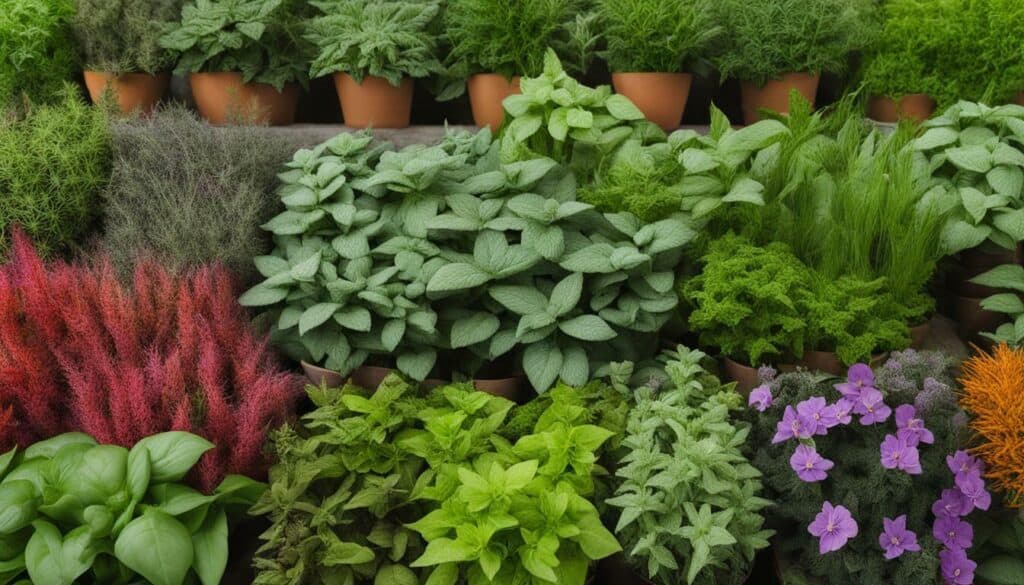
Remember to always consult with a healthcare professional before using any medicinal herbs, especially if you have underlying health conditions or are taking medication.
Starting Your Medicinal Herbs from Seeds or Seedlings
Growing medicinal herbs from seeds or seedlings is an exciting and rewarding way to start your herb garden. Whether you choose to start from seeds or purchase seedlings, each method has its own benefits and considerations. Let’s explore both options to help you make an informed decision.
Starting from Seeds
Starting your medicinal herbs from seeds allows you to have a wider variety of plant options and is generally more cost-effective. Here are some steps to get started:
- Choose high-quality seeds: Look for organic, non-GMO seeds that are specifically labeled for medicinal herbs.
- Plan your planting schedule: Determine the optimal time to start your seeds indoors, based on your climate and the specific requirements of each herb.
- Prepare your containers: Use seed trays or small pots with well-draining soil. Ensure that the containers have drainage holes to prevent waterlogging.
- Sow the seeds: Follow the instructions on the seed packet for the recommended planting depth and spacing. Water lightly after sowing.
- Provide adequate light and warmth: Place the containers in a warm area with sufficient sunlight or use grow lights to simulate natural sunlight.
- Water and care for the seedlings: Keep the soil moist but not waterlogged. Thin out the seedlings if they are overcrowded to ensure proper growth.
- Harden off the seedlings: Gradually expose the seedlings to outdoor conditions by placing them outside for increasing periods over several days.
- Transplant to the garden: Once the seedlings are hardened off and the risk of frost has passed, transplant them into your prepared garden beds or containers.
Starting from seeds requires patience and careful monitoring of the growing conditions, but it offers a sense of satisfaction and control over the entire growth process.
Starting from Seedlings
If you prefer a faster and more convenient option, starting your medicinal herbs from seedlings is a great choice. Here are some considerations:
- Purchase healthy seedlings: Look for reputable nurseries or local farmers’ markets that offer organic seedlings of medicinal herbs.
- Check for quality: Inspect the seedlings for healthy foliage, strong stems, and well-developed root systems.
- Prepare the planting area: Clear the soil of any weeds or debris and ensure proper drainage.
- Transplant the seedlings: Dig holes in the planting area that are slightly larger than the root ball of each seedling. Gently place the seedlings in the holes and backfill with soil.
- Water and care for the seedlings: Provide adequate water to help the seedlings establish themselves in their new environment. Follow the specific care instructions for each herb.
Starting from seedlings allows you to skip the initial germination and early growth stages, giving you a head start in your herb garden.
Remember: Regardless of whether you choose to start from seeds or seedlings, ensure that your plants receive proper care, including regular watering, adequate sunlight, and protection from pests and diseases. Monitor their growth and make any necessary adjustments to ensure their well-being.
Tip: Starting small with a few herbs that fit your specific needs can help you manage your garden effectively and build confidence as you learn and grow.
In conclusion, starting your medicinal herbs from seeds or seedlings is a personal choice based on your preferences and resources. Both methods have their advantages, and either option can lead to a successful and thriving herb garden. Choose the approach that aligns with your gardening goals and enjoy the process of nurturing your plants from start to harvest.

The Benefits of Growing Medicinal Herbs
Growing medicinal herbs in your own garden can provide a multitude of benefits for both your health and well-being. Here are a few reasons why you should consider starting your own medicinal herb garden:
1. Access to Natural Remedies
By growing your own medicinal herbs, you have easy access to a wide range of natural remedies. From soothing teas to healing salves, having these herbs readily available allows you to treat common ailments such as colds, headaches, and digestive issues naturally.
2. Cost-effective Solution
Herbal remedies can be expensive when purchased from stores. By growing your own medicinal herbs, you can save money in the long run while still reaping the benefits of natural healing. Plus, you’ll have an abundant supply of herbs to share with friends and family.
3. Chemical-free Alternatives
Commercially produced medicines often contain chemicals and synthetic ingredients. By growing your own medicinal herbs, you can ensure that the remedies you use are free from harmful substances and are completely natural.
4. Connection to Nature
Gardening is a great way to connect with nature and find solace in the earth. Spending time tending to your medicinal herb garden allows you to immerse yourself in the sights, smells, and sounds of the natural world, promoting a sense of peace and well-being.
5. Sustainable and Eco-friendly
When you grow your own medicinal herbs, you have control over the cultivation process. You can choose to garden organically, using sustainable and eco-friendly practices that are beneficial to both your health and the environment.
6. Educational Experience
Starting a medicinal herb garden provides an opportunity for continuous learning. As you tend to your herbs and research their uses, you’ll develop a deeper understanding of their healing properties and how to utilize them effectively.
7. Self-sufficiency
Growing your own medicinal herbs empowers you to take control of your health and well-being. Instead of relying solely on store-bought remedies, you can become self-sufficient and harness the power of nature to support your overall wellness.
By starting your own medicinal herb garden, you can experience these benefits and more. So why wait? Begin your herb gardening journey today and unlock the healing potential of nature.
FAQ
Q: Are medicinal herbs safe to use?
A: Yes, when used responsibly and in consultation with a healthcare provider, medicinal herbs can be safe and effective.
Q: How do I determine which medicinal herbs to grow?
A: Start by making a list of the common ailments in your family and choose herbs that can address those specific needs.
Q: Can I grow medicinal herbs in containers?
A: Yes, many medicinal herbs can be grown successfully in containers, making them a great option for small spaces or patio gardens.
Q: Should I start my medicinal herbs from seeds or seedlings?
A: It depends on your preference and availability. Starting from seeds is more economical, but seedlings allow for quicker harvesting.
Q: How do I prepare the soil for my medicinal herbs?
A: Amend the soil with organic compost and aged manure to create a nutrient-rich growing environment for your herbs.
Q: What are some companion plants for medicinal herbs?
A: Herbs like thyme, basil, and calendula make excellent companions for vegetable gardens and can be added to the corners of the beds.
Q: How can I stay connected to nature through my medicinal herb garden?
A: By growing your own medicinal herbs, you are creating a link between humanity and nature, fostering a sense of connection and empowerment.
What Are Some Easy Tips for Starting an Herb Garden at Erie Basin Marina Gardens?
Starting an herb garden at erie basin marina gardens: a natural oasis is a breeze with these easy tips. Firstly, choose a sunny spot with well-draining soil. Next, select your favorite herbs to grow, such as basil, mint, or rosemary. Remember to water your plants regularly and provide adequate drainage to avoid overwatering. Lastly, protect your plants from pests by using organic pest control methods.

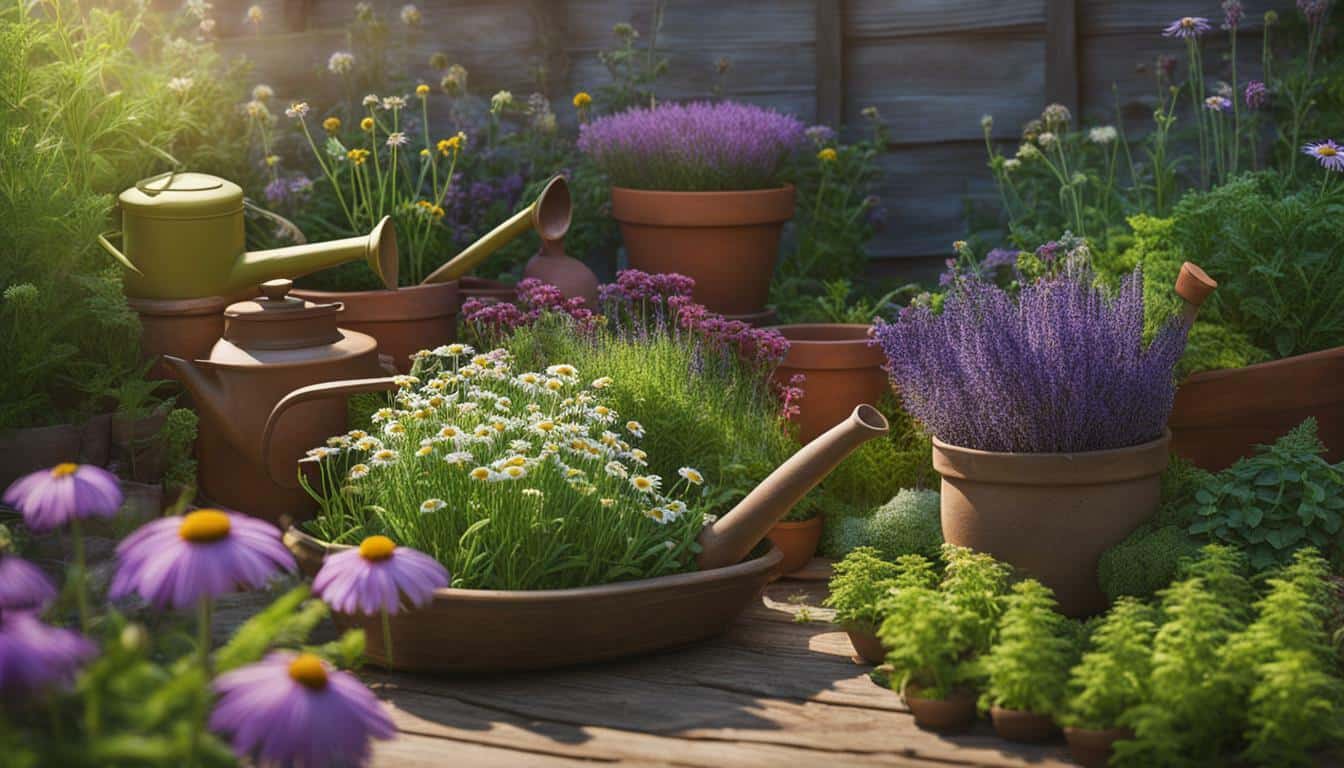



Leave a Reply